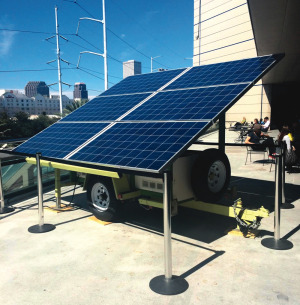BioCycle November 2014
Life-Cycle Assessment Of Food Waste Treatments
The Oregon Department of Environmental Quality (DEQ) recently released Evaluation of Climate, Energy, and Soils Impacts of Selected Food Discards Management Systems, the final product of a study commissioned by DEQ to provide a systematic literature review and harmonization of life cycle assessment (LCA) studies for one or more of the following targeted food waste treatments: Aerobic composting; Anaerobic digestion; In-sink grinding via a food waste disposer, flushing to sewer, and management with other sewerage at a wastewater treatment plant; and/or Landfill. The project consulting team included Sally Brown (University of Washington), Matt Cotton (Integrated Waste Management Consulting, LLC), H. Scott Matthews (Avenue C Advisors, LLC), and Jeffrey Morris (Sound Resource Management Group, Inc.). Metro, the regional government in Portland (Oregon), provided grant funding for the study.
The project team was asked to record and assess climate, energy and soil productivity impacts for each of the food waste treatments. Because LCA literature does not directly address soil productivity as an impact category, Dr. Brown chronicled the scientific literature on increased plant and soil productivity resulting from organic amendments to develop a qualitative ranking for each treatment in four categories of potential benefits: Soil carbon sequestration; Fertilizer replacement; Water conservation; and Yield increase. Although each benefit has the potential for impacts on climate and energy use, in this study, only climate and energy impacts of fertilizer replacement and climate impacts of soil carbon sequestration are quantified.
Food waste treatment rankings varied depending on impact category. Aerobic composting (AC) and anaerobic digestion always rank first or second, although AC ranks last on energy because electric power is not an output of the aerobic composting process. Landfill always ranks last (except for energy), and in-sink grinding is always third except for energy where it ranks first. The project team also determined harmonized impacts for each treatment’s food waste management stages and the harmonized credits for the energy and material outputs of each option.
Food Residue In Food Service Packaging
In October, the Foodservice Packaging Institute (FPI) released findings of its second study examining levels of food residue on food service packaging in the residential recycling stream. The purpose of this new study was to corroborate findings of a study that occurred last year in Boston that found no substantial difference in the amount of contamination between food service packaging and broader types of food packaging typically associated with curbside recycling programs. In the new study, researchers sampled approximately 2,600 pounds of randomly selected residential recyclables (i.e. corrugated, mixed paper, tubs and lids) collected across southern Delaware, and divided them into two categories: food service packaging or other packaging in contact with food. Utilizing the same visual ranking system developed during the Boston study, the research team was able to rate and record how much food resided on the materials in each category. Again, the team found that levels of food residue on food service packaging are comparable to commonly recycled food packaging.
“One of the most common reasons that municipal programs do not accept food service packaging is the concern about increased levels of food contamination in recyclables,” notes Lynn M. Dyer, FPI President. “The encouraging results of the Delaware study provide a different representative sample of food residue on foodservice packaging. They assist in corroborating our findings of food service packaging residue as a perceived barrier in recycling programs rather than a real obstacle.”
Insurance Companies Ill Prepared For Climate Change
The National Association of Insurance Companies (NAIC) and Ceres, a nonprofit organization advocating for sustainability leadership, recently released Insurer Climate Risk Disclosure Survey Report & Scorecard: 2014 Findings and Recommendations. The report is based on results of a survey on climate change preparedness distributed by the NAIC to 330 insurers of varying size. According to Ceres, the aim of the report is “to provide regulators, insurers, investors and other stakeholders with substantive information about the risk insurers face from climate change and the steps insurers are taking — or not taking — to respond to those risks.” Among the findings:
– 83 percent of survey respondents are lacking preparedness in addressing climate-related risks and opportunities. Three percent, or 9 insurers, earned a “leading” rating, while the rest earned “beginning” or “minimal” ratings.
– Larger insurers showed stronger climate risk management practices than smaller companies. Property and casualty insurers showed more advanced understanding of the risks that climate change poses to their business, and are further along in developing tools needed to manage climate change risks when compared to the life and annuity and health insurance sectors.
– Despite increased evidence that extreme heat waves and other climate-related impacts will influence morbidity and mortality trends, life and annuity and health insurers showed widespread indifference to climate risk, both in regard to their core business lines and their investment strategies;
– Only 38 of 330 companies have issued public climate risk management statements that articulate the company’s understanding of climate science and its implications for core underwriting and investment portfolios.
– Over the past 30 years, annual losses from natural catastrophes have continued to increase while the insured portion has declined.
Recommendations in the report for all U.S. insurance sectors include: Develop climate risk oversight at the board and c-suite levels; Issue a comprehensive, public corporate policy on climate risk; and Improve climate change scenarios and impact assessments.
Greenbuild’s On-Site Hybrid Microgrid
The 2014 Greenbuild International Conference and Expo, held at the Morial Convention Center in New Orleans, Louisiana from October 22-24, featured a 1,500-square foot Net Zero Zone, where exhibit space was fully powered by an on-site hybrid microgrid — a system of local electric power generation, storage and distribution that can operate in combination with the local utility grid or in isolation from it. The Net Zero Zone, which featured “portable” solar panels, was designed using EMerge Alliance standards for the hybrid use of alternating current (AC) and direct current (DC) power in buildings, and exhibits the efficiency, reliability and resiliency of hybrid microgrids. The EMerge Alliance is currently involved in more than 50 hybrid AC/DC microgrids being tested and showcased globally, including at Michigan’s Treasury building in Flint, Michigan.
Carbon Investment Management Organization
The Climate Trust, a nonprofit that has specialized in climate solutions since 1997, announced its new “Carbon Investment Management Organization (CIMO)” business model, stating it offers greater potential for impact through investments in critical early-stage projects. Working within the new CIMO model, The Climate Trust, based in Portland, Oregon, will give capital to projects in the agricultural, forestry and biogas sectors that will in turn generate offsets. The Climate Trust will remain actively involved with project developers to ensure healthy yields of credits and increased revenues (for the project developers) from the sale of the environmental credits. “The Trust’s CIMO model represents a new, but complementary, component of the organization’s commitment to promoting durable climate solutions,” states Laura Beane, Board Chair and Director of Regional Market Structure & Policy for Iberdrola Renewables. “Early-stage funding, a guaranteed buyer for the project’s future credits, and access to the Trust’s technical experts will combine to enable new project development and meaningful carbon mitigation.”











